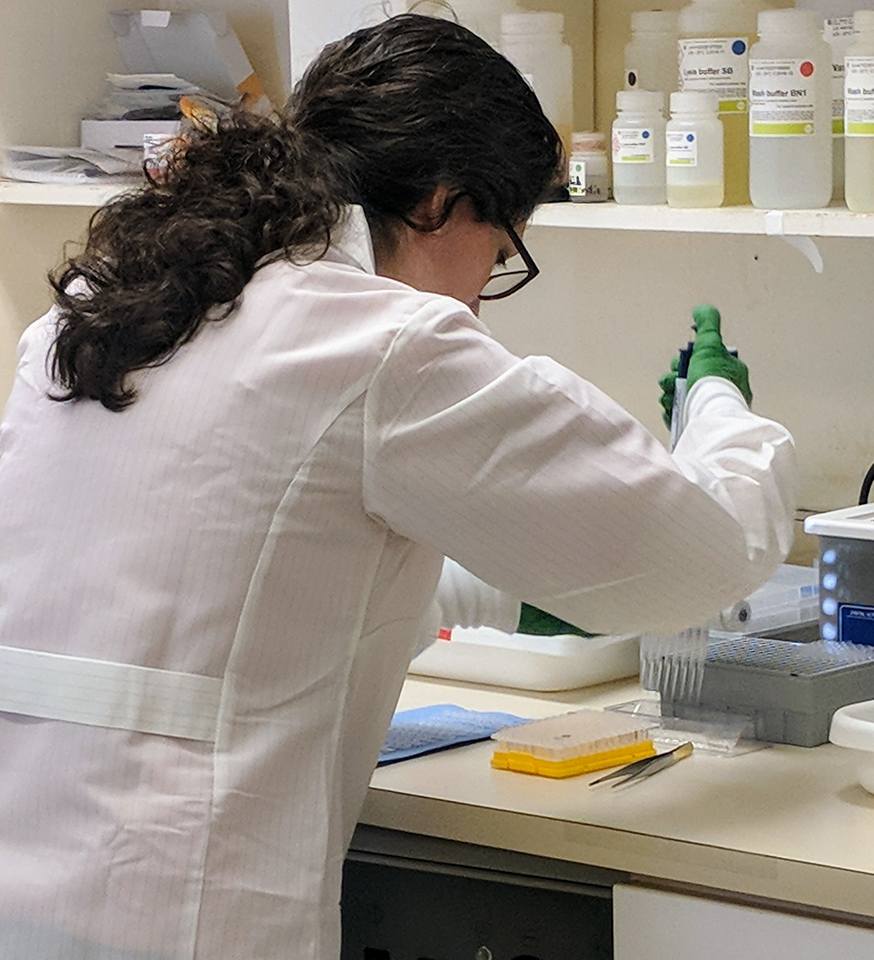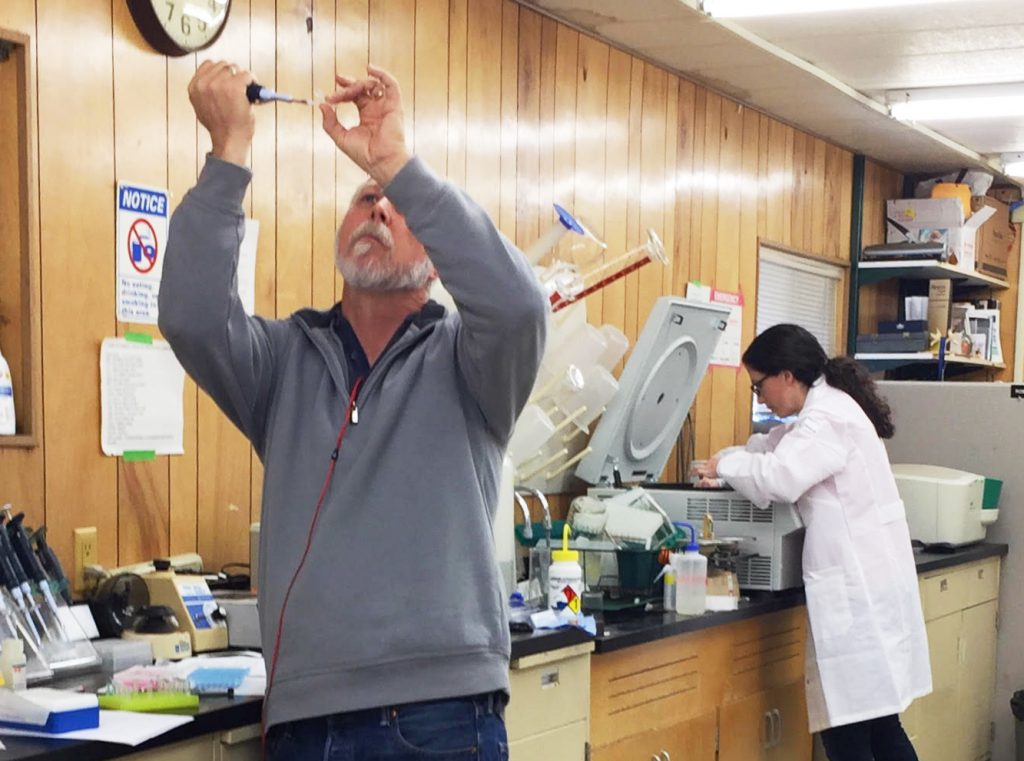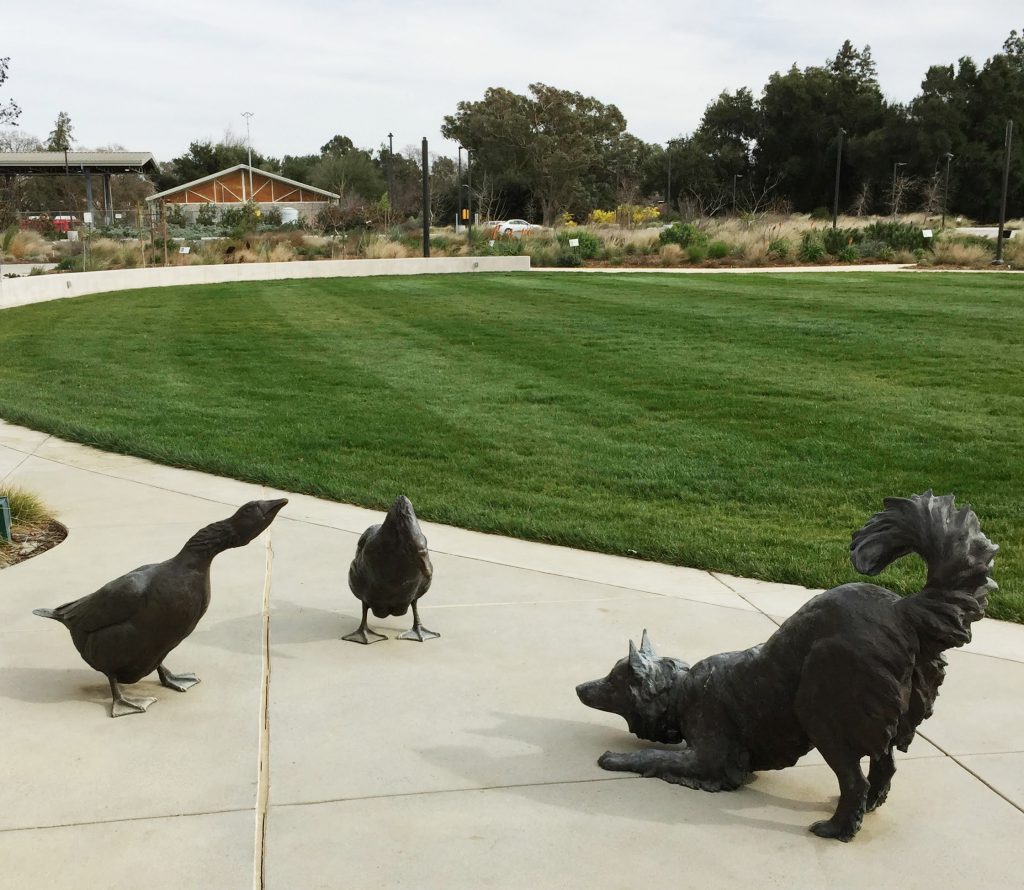
About the Canine Genetic Diversity test from the UC Davis Veterinary Genetics Lab: Part I
 The UC Davis Veterinary Genetics lab is an informal looking place, housed in a series of small, indistinct beige buildings away from the main campus of the University of California at Davis, where their enormous vet school, complete with dairy herd in constant full view, teach the next generation of large and small animal vets. Over at the VGL, there are remnants of livestock yards and barns in this out-of-the-way complex, along with at least one open barn fille d with hay, and in each small building there are friendly, fresh faced Californians. They are serious in a easy going way – diligently doing research during the week and probably being generally outdoorsy on evenings and weekends. That could be my impression as an upstate New Yorker visiting happily in February, but it was a lovely impression. These are true animal people, from the patient customer service folks to the hardworking mailroom workers to the lab techs who extract the DNA to the lovely woman reading the results, new agility puppy at her feet. The new director, Dr. Rebecca Bellone, is a horse geneticist who seems to be assembling a team of superwomen grad students who never quite left the horse-crazy phase behind while pursuing their advanced degrees. From lab techs to future professors, the staff members here seem to be channeling their love of animals into solving complex puzzles that will help those animals. It’s a hopeful venture – refreshing because we tend to hear a lot of gloom and doom about the state of our breeds, and I’m relieved to know that these are the teams working away in these nondescript buildings, testing DNA on any number of species, making the world better.
The UC Davis Veterinary Genetics lab is an informal looking place, housed in a series of small, indistinct beige buildings away from the main campus of the University of California at Davis, where their enormous vet school, complete with dairy herd in constant full view, teach the next generation of large and small animal vets. Over at the VGL, there are remnants of livestock yards and barns in this out-of-the-way complex, along with at least one open barn fille d with hay, and in each small building there are friendly, fresh faced Californians. They are serious in a easy going way – diligently doing research during the week and probably being generally outdoorsy on evenings and weekends. That could be my impression as an upstate New Yorker visiting happily in February, but it was a lovely impression. These are true animal people, from the patient customer service folks to the hardworking mailroom workers to the lab techs who extract the DNA to the lovely woman reading the results, new agility puppy at her feet. The new director, Dr. Rebecca Bellone, is a horse geneticist who seems to be assembling a team of superwomen grad students who never quite left the horse-crazy phase behind while pursuing their advanced degrees. From lab techs to future professors, the staff members here seem to be channeling their love of animals into solving complex puzzles that will help those animals. It’s a hopeful venture – refreshing because we tend to hear a lot of gloom and doom about the state of our breeds, and I’m relieved to know that these are the teams working away in these nondescript buildings, testing DNA on any number of species, making the world better.
It’s from that environment that the canine diversity test we at BetterBred use arose. BetterBred wouldn’t exist if it hadn’t. We didn’t plan to make a company – the necessity for what we offer simply became obvious and we set out to make it. Once we started, however, we knew other breeds would need it, too, and so BetterBred was born. But before that point, I was just a hobby breeder with a Standard Poodle genetic diversity email list, a former journalist and editor and mostly a mom. That email list had loosely connected breeders concerned about a genetic bottleneck in our breed, breeders willing to do something about it. After finding as many old lines of poodles we could, we needed to know if our unusual pedigrees could be proven unusual with genetic data. Unbeknownst to us, Dr. Niels C. Pedersen was developing a test to do just that, but he didn’t have a large set of dogs to test. Since he’d recently done some genetic assessments of more mainstream poodles, I emailed him in July of 2014 wondering if he could help us. Everything we have now was an outgrowth of that chance email.
It is important to note that the impetus for Dr Pedersen’s test was the desire to help breeders breed healthier dogs. He believes, like many conservation geneticists, that maximizing retention of genetic diversity is key to keeping genetic disease from becoming common in a closed gene pool – which every purebred dog breed is. Every interaction I’ve had with Dr Pedersen proved he was just as much of a veterinarian trying to help dogs as any vet I’ve ever seen in any office. As a former director of UC Davis’ huge Center for Companion Animal Health, his singular goal was to help dogs be healthier. He has published a lifetime of papers and made many breakthroughs (mostly in cat medicine), and it was clear that his development of this test was not about creating commercial applications for himself. Nearing retirement, he didn’t do it for the sake of his own glory, either. With the advanced facilities at the CCAH, he had all possible technologies available to him, so in developing the canine genetic test he chose the method he thought best and most practical for the task, considering breeders’ needs, ease of use, cost, speed and accuracy.
Another important aspect of our study with Dr. Pedersen is that he interacted with dozens of breeders. His major recent papers on Standard Poodles and Italian Greyhounds, in fact, included working closely enough with knowledgeable breeders that he included them as co-authors. For our Standard Poodle paper, he worked with both me and Lynn Brucker, who publishes the Standard Poodle Database and has decades of collecting historical knowledge and private health records, having talked to all the breeders of legend with influence on the breed. Dr Pedersen had some preconceived notions from previous studies about our breed, but wisely and generously was willing to look at our evidence that in some cases contradicted what had come to be accepted about the breed. Lynn provided masterful analysis of the health data in pedigree database that corroborated the genetic data. This kind of deep, breed-specific assessment is an example of the collective knowledge breeders offer researchers who listen to them and don’t just view them as a market to please or persuade.
Conscientious breeders are deeply committed to producing healthy, happy, beautiful puppies and placing them in appropriate homes. They spend hundred of dollars on each puppy before they ever go to their forever homes, preparing them for long lives and successful placements. No one has the same emotional investment, let alone financial, in keeping their lines and breeds as healthy as possible – except perhaps veterinarians like Dr. Pedersen and the people at the Veterinary Genetics Lab who work so hard to help breeders.
There are commercial test companies that use a different method, and because they are competitive for market share, they will put down the method Dr. Pedersen chose. They have to, because they perceive that as their competitive advantage – just like at dog shows, when competitors trash their competition, either obviously or subtlely. We too, at BetterBred, are now competitors in that realm, which is a sort of necessary evil, since we set out to support breeders and pay our costs. We think our methods are superior too, or we wouldn’t use them! But in the future, as you read about how many markers one test has vs. another, how many disease tests one has vs. another, how one kind of technology is better than another, keep in mind the vet behind the scenes, who spent a lifetime listening to and serving breeders – all to keep animals healthy.

 Previous Post
Previous Post Next Post
Next Post


